St Ailbe’s Creamery just outside the village of Emly in west Co Tipperary was built around 1900 and is a typical creamery of the time. Creameries were like small factories; where milk was made into butter for export to cities both in Ireland and England. Creameries provided employment to men and women and therefore were important centres in rural communities with the sale of butter to London a major source of income for farmers and the local economy. The creamery day started at eight when farmers arrived with their milk from the previous evening and that ?morning’s milking.
Farm household operations
At this time, a typical farmer would farm 30 acres that they would own, have 14 cows, a few calves and pigs, 10 laying hens that were left outside during the day, chickens were reared for eating, a working horse and a vegetable garden, half an acre in size. There here were cooking and eating apple trees. Also fruit bushes with black currents, raspberries and gooseberries. Calves would be sold in October at fairs. Farmyard manure was the fertilizer used to enrich the topsoil.
In the kitchen butter was made by pouring milk into a basin and waiting overnight for the cream to separate and float to the top. The cream was scooped off and then rotated by hand in a churn to make butter. The buttermilk was a by-product used to make bread. ?Wives would rear the calves in the spring, knit, wash, cook, keep the house and look after the finances. On the same day each week, clothes were washed by hand on a washing board, the water carried from the well in buckets. The nights were lit by kerosene lamp.
In October a pig would be ?slaughtered, the carcass was cut into pieces and the cuts placed in a 45 gallon timber barrel that was a repurposed wine barrel known as a stan, with salt to preserve the meat. After six weeks the meat would be hung from the ceiling in the kitchens. The blood would be mixed with barley, rice, onions and seasoning and packed in the pig’s gut to make black pudding rings. The pig’s bladder would be used as a football, its fat with ash was made into soap.
On Sundays a pony and trap would take the family to mass and to visit family after dinner. Six children was typical, walking to school with their bag and lunch, although a farmer on his way to the creamery might allow children to ride on the cart.
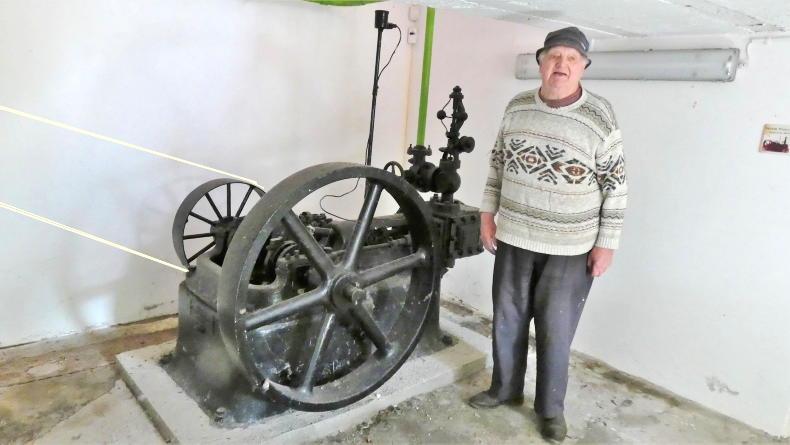
Steam Engine with fly wheel and pully that drove belt to rotate drive shafts and pullies. Industrial Churn for Butter making - Rotated and turned cream into butter, Buttermilk was also produced Steam Boiler Coal Fired Cream Centrifugal Separator - Milk was spun inside at speed separating the cream and skim milk
At harvest and sowing times farmers would help each other and share machinery. A farmer would plough one acre per day with two horses and walk 12 miles in doing so. Farmers used environmentally friendly methods with minimum waste, almost self-sufficient producing their own fresh food with zero food miles and kitchen food. Waste was fed to pigs and chickens - early recycling. Generally, farmyards were surrounded on four sides by the farm house, milking shed, stable, stores, hay barn, cart house, hen houses and piggeries.
Delivery systems
The cows would be brought from the fields into the farmyard for milking. Prior to the introduction of electricity and milking machines in the ?1950s, cows were hand milked into buckets, twice a day, mainly by the farmer’s wife and daughters, sitting on stools. A woman would milk up to 10 cows, the cows giving up to two gallons per milking. That milk was poured into churns through a strainer with cheesecloth to catch hairs and any dirt. The churns then loaded onto a cart and drawn to the creamery, perhaps many miles away. In hot weather farmers would place the churns with milk in streams to cool the milk so it would not sour.
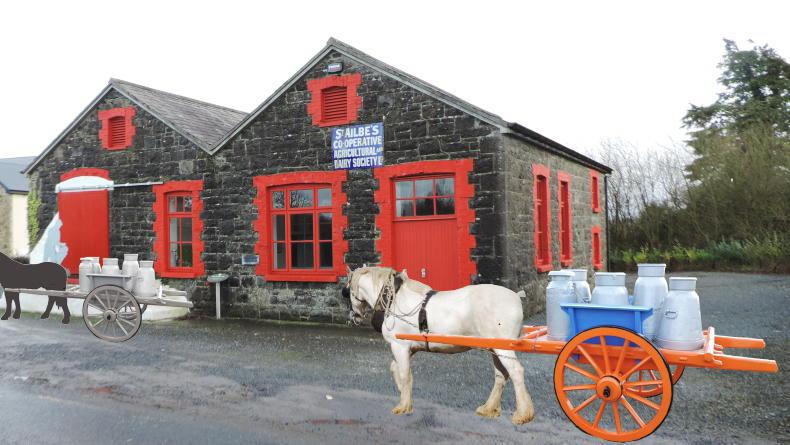
St Ailbe’s Creamery just outside the village of Emly in west Co Tipperary was built around 1900 and is a typical creamery of the time.
The horses and carts would queue up outside the creameries and the farmers would talk about the weather, local news, what they were doing on their farms and prices at cattle fairs. The horse carts would line up beside the unloading platform at the intake area and the churns would be rolled inside. Farmers would help each other to roll and lift the steel churns, typically 10 and 20 gallons (78 kilograms), from the carts onto the platform and inside and pour the milk into an open top stainless basin part of a weighing scales. The milk would be weighed and recorded. Each farmer was assigned a reference number. Samples of the milk would be taken in small bottles for testing.
Eighty farmers supplied milk to St Ailbe’s, delivering 5,000 gallons of milk that was processed daily. A small book was kept by the farmer to record the date and volume of milk that he delivered. The creamery also recorded the details in their book. Farmers were paid for the butter fat content of the milk, at the end of the month by cheque.
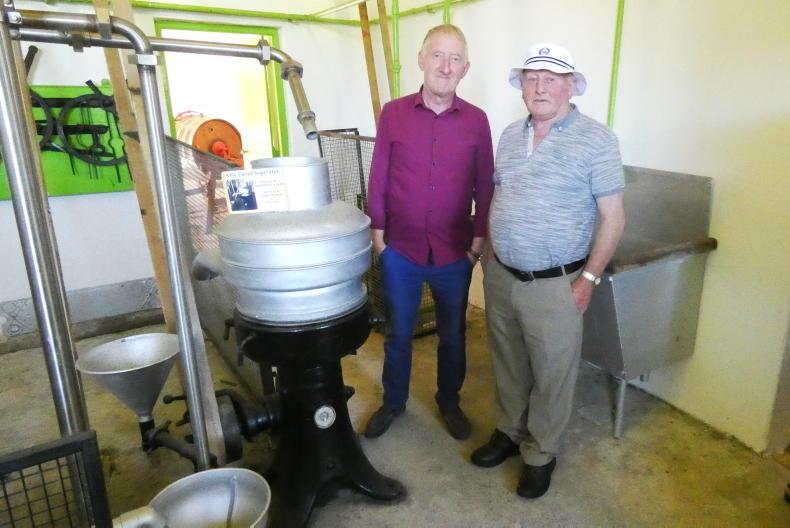
Steam Engine with fly wheel and pully that drove belt to rotate drive shafts and pullies. Industrial Churn for Butter making - Rotated and turned cream into butter, Buttermilk was also produced Steam Boiler Coal Fired Cream Centrifugal Separator - Milk was spun inside at speed separating the cream and skim milk
Creamery operations
The milk was temporarily stored in one of two open top stainless steel holding tanks from where the milk was piped to a separator and onto a cream cooler. The milk would flow through pipes to the centrifugal milk cream separator where the cream was separated from the whole milk, leaving skim milk that was used by farmers to feed pigs and calves. In the cream cooler, the cream flowed down over a ribbed cooled metal surface. From the cooler the cream was pumped through pipes to the industrial butter churn where the cream was turned into butter. Salt was added as a preservative and for taste. It took 20 minutes to make the butter and again the buttermilk was used in baking.
The butter was placed in tapered wooden boxes lined with greaseproof paper - the butter, each firkin weighing 56 pounds - ?and shipped to England by train and boat. The delivery time to London was 24 hours. It took 150 gallons of milk to make a firkin of butter.
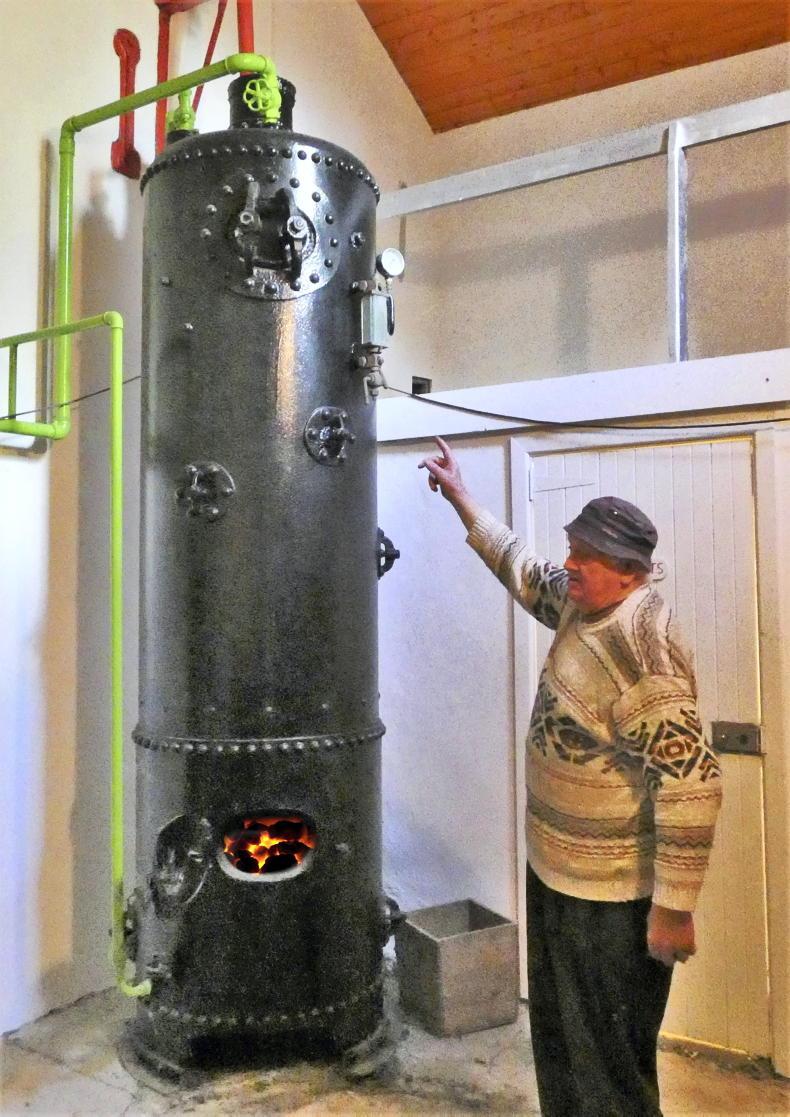
Steam Engine with fly wheel and pully that drove belt to rotate drive shafts and pullies. Industrial Churn for Butter making - Rotated and turned cream into butter, Buttermilk was also produced Steam Boiler Coal Fired Cream Centrifugal Separator - Milk was spun inside at speed separating the cream and skim milk
Time moving on
By the 1970s farmers had started to install large refrigeration tanks in their milking parlours and tanker lorries would call to take the milk to larger milk processing plants. Milking parlours where six cows at a time were milked by machine were built and the rest as we say is … history.
Read more
John Connell: exploring the hinterland of the heart
Musings by Cormac: Olympic gold- hopes, dreams & inspiration
St Ailbe’s Creamery just outside the village of Emly in west Co Tipperary was built around 1900 and is a typical creamery of the time. Creameries were like small factories; where milk was made into butter for export to cities both in Ireland and England. Creameries provided employment to men and women and therefore were important centres in rural communities with the sale of butter to London a major source of income for farmers and the local economy. The creamery day started at eight when farmers arrived with their milk from the previous evening and that ?morning’s milking.
Farm household operations
At this time, a typical farmer would farm 30 acres that they would own, have 14 cows, a few calves and pigs, 10 laying hens that were left outside during the day, chickens were reared for eating, a working horse and a vegetable garden, half an acre in size. There here were cooking and eating apple trees. Also fruit bushes with black currents, raspberries and gooseberries. Calves would be sold in October at fairs. Farmyard manure was the fertilizer used to enrich the topsoil.
In the kitchen butter was made by pouring milk into a basin and waiting overnight for the cream to separate and float to the top. The cream was scooped off and then rotated by hand in a churn to make butter. The buttermilk was a by-product used to make bread. ?Wives would rear the calves in the spring, knit, wash, cook, keep the house and look after the finances. On the same day each week, clothes were washed by hand on a washing board, the water carried from the well in buckets. The nights were lit by kerosene lamp.
In October a pig would be ?slaughtered, the carcass was cut into pieces and the cuts placed in a 45 gallon timber barrel that was a repurposed wine barrel known as a stan, with salt to preserve the meat. After six weeks the meat would be hung from the ceiling in the kitchens. The blood would be mixed with barley, rice, onions and seasoning and packed in the pig’s gut to make black pudding rings. The pig’s bladder would be used as a football, its fat with ash was made into soap.
On Sundays a pony and trap would take the family to mass and to visit family after dinner. Six children was typical, walking to school with their bag and lunch, although a farmer on his way to the creamery might allow children to ride on the cart.

Steam Engine with fly wheel and pully that drove belt to rotate drive shafts and pullies. Industrial Churn for Butter making - Rotated and turned cream into butter, Buttermilk was also produced Steam Boiler Coal Fired Cream Centrifugal Separator - Milk was spun inside at speed separating the cream and skim milk
At harvest and sowing times farmers would help each other and share machinery. A farmer would plough one acre per day with two horses and walk 12 miles in doing so. Farmers used environmentally friendly methods with minimum waste, almost self-sufficient producing their own fresh food with zero food miles and kitchen food. Waste was fed to pigs and chickens - early recycling. Generally, farmyards were surrounded on four sides by the farm house, milking shed, stable, stores, hay barn, cart house, hen houses and piggeries.
Delivery systems
The cows would be brought from the fields into the farmyard for milking. Prior to the introduction of electricity and milking machines in the ?1950s, cows were hand milked into buckets, twice a day, mainly by the farmer’s wife and daughters, sitting on stools. A woman would milk up to 10 cows, the cows giving up to two gallons per milking. That milk was poured into churns through a strainer with cheesecloth to catch hairs and any dirt. The churns then loaded onto a cart and drawn to the creamery, perhaps many miles away. In hot weather farmers would place the churns with milk in streams to cool the milk so it would not sour.

St Ailbe’s Creamery just outside the village of Emly in west Co Tipperary was built around 1900 and is a typical creamery of the time.
The horses and carts would queue up outside the creameries and the farmers would talk about the weather, local news, what they were doing on their farms and prices at cattle fairs. The horse carts would line up beside the unloading platform at the intake area and the churns would be rolled inside. Farmers would help each other to roll and lift the steel churns, typically 10 and 20 gallons (78 kilograms), from the carts onto the platform and inside and pour the milk into an open top stainless basin part of a weighing scales. The milk would be weighed and recorded. Each farmer was assigned a reference number. Samples of the milk would be taken in small bottles for testing.
Eighty farmers supplied milk to St Ailbe’s, delivering 5,000 gallons of milk that was processed daily. A small book was kept by the farmer to record the date and volume of milk that he delivered. The creamery also recorded the details in their book. Farmers were paid for the butter fat content of the milk, at the end of the month by cheque.

Steam Engine with fly wheel and pully that drove belt to rotate drive shafts and pullies. Industrial Churn for Butter making - Rotated and turned cream into butter, Buttermilk was also produced Steam Boiler Coal Fired Cream Centrifugal Separator - Milk was spun inside at speed separating the cream and skim milk
Creamery operations
The milk was temporarily stored in one of two open top stainless steel holding tanks from where the milk was piped to a separator and onto a cream cooler. The milk would flow through pipes to the centrifugal milk cream separator where the cream was separated from the whole milk, leaving skim milk that was used by farmers to feed pigs and calves. In the cream cooler, the cream flowed down over a ribbed cooled metal surface. From the cooler the cream was pumped through pipes to the industrial butter churn where the cream was turned into butter. Salt was added as a preservative and for taste. It took 20 minutes to make the butter and again the buttermilk was used in baking.
The butter was placed in tapered wooden boxes lined with greaseproof paper - the butter, each firkin weighing 56 pounds - ?and shipped to England by train and boat. The delivery time to London was 24 hours. It took 150 gallons of milk to make a firkin of butter.

Steam Engine with fly wheel and pully that drove belt to rotate drive shafts and pullies. Industrial Churn for Butter making - Rotated and turned cream into butter, Buttermilk was also produced Steam Boiler Coal Fired Cream Centrifugal Separator - Milk was spun inside at speed separating the cream and skim milk
Time moving on
By the 1970s farmers had started to install large refrigeration tanks in their milking parlours and tanker lorries would call to take the milk to larger milk processing plants. Milking parlours where six cows at a time were milked by machine were built and the rest as we say is … history.
Read more
John Connell: exploring the hinterland of the heart
Musings by Cormac: Olympic gold- hopes, dreams & inspiration











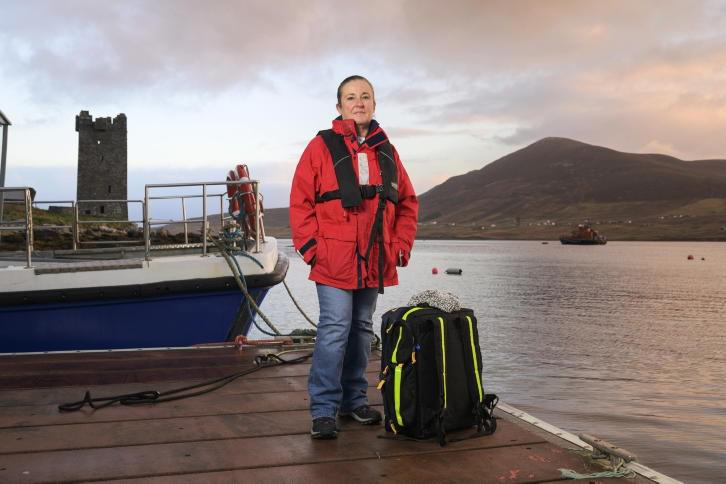
SHARING OPTIONS